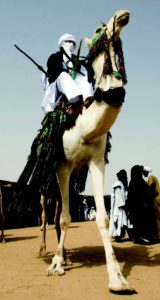Ethiopian missions: A history of prayer and sacrifice
AfriGO Team

The Gospel first arrived in Ethiopia nearly 2,000 years ago. The Holy Spirit sent Philip into the desert to explain the scriptures to an Ethiopian official in the court of Queen Candace (Acts 8). Today, the Holy Spirit is sending Ethiopians into the desert to open the Scriptures to others.
An emerging focus among some mission leaders in Ethiopia is the nomadic Fulani people of West Africa, who live on the rim of the Sahara Desert. Their population, estimated at 40 million in 20 countries, is largely Muslim, and many practice indigenous religions. The Fulani and Ethiopians look like siblings, and legend says the Fulani originated from Ethiopia. In one Hadith, Muhammed forbade his followers from harming Ethiopians, making them natural friends now.
The East Africa Office (EAO), led by Worku Hailemariam, hosted a two-day conference in Addis Ababa in June 2019, drawing attendees from various churches and denominations. Among the attendees was Tambaya Ibrahim, a Fulani church leader from Niger. He directs a Fulani Bible school and serves on a scripture translation team. (Famines in 1974 and 1984 sent people from his community in the desert south in search of food, where they encountered the gospel.) Tambaya and Rev. Gashaw, Ethiopian missionary to Mali, gave an altar call, and eight responded, committing themselves to help reach the Fulani.
Ethiopian evangelicals have a long history of sending missionaries cross-culturally within Ethiopia. The two largest denominations are the Kale Heywet Church, founded nearly 100 years ago, and the Mekane Yesus, which is even older.
Together and by themselves, the Ethiopian Kale Heywet church Global Mission, Evangelical Church Mekane Yesus mission agency, called International Mission Society, and the EAO have sent out over 60 missionaries outside Ethiopia, all supported by their home churches. The EAO is now also sending Kenyans, Eritreans, Tanzanians and Ugandans through its office. Five families of the EKHC, sent through EAO, now serve among the Fulani in Ghana, Niger, Mali, and Guinea, with more arriving in Nigeria in the future.
A history of prayer
Prayer has been central to missions history in Ethiopia. Desta Langena, director of the Ambaricho International Prayer and Missions Movement (AIPM) tells this story.
The communist government, which took over the country’s political system in 1974, sent lecturers and students out into communities to eradicate illiteracy and introduce communist ideology. One day, they went to the house of a witchdoctor named Aba-Sarecho on Ambaricho mountain, and removed all of the satanic worship items, warning him not to continue his rituals. This was the beginning of the end for idolatrous worship by the Kambatta people on Ambaricho mountain, and evidence that God can use anything – even communism – to break strongholds.
 Despite intense persecution, the Kambatta Church grew and believers prayed, worshipped, and influenced society.
Despite intense persecution, the Kambatta Church grew and believers prayed, worshipped, and influenced society.
In 1990 revival broke out at Teza Kale Heywet Church. An evangelist Tesfaye Gebre spent 30 days fasting and praying for the manifestation of God’s glory. He gathered more than 25 praying Christians to join him. When the revival came, more than 25,000 people came to Christ and more than 30,000 received miraculous healing.
News spread, and many more began climbing Ambaricho mountain for intercessory prayer. People committed to evangelism and church planting. After years of prayer, the 22nd Aba- Sarecho witchdoctor accepted Christ as his personal Saviour.
In 2003 the newly-formed Ambaricho International Prayer and Missions Movement (AIPM) sent its first pioneer missionary. Today there are 346 missionaries sent by AIPM to work outside their own ethnic group. This has led to the salvation of more than 50,000 people and the planting of 750 churches all over Ethiopia.1
Six months after the EAO began in 2012, it helped to found the Ethiopian Global Mission Network, a network of close to 20 denominations, ministries and mission agencies. Their vision to is see Ethiopia become a strong missionary sending country.
A history of sacrifice
 Believers in Ethiopia are no strangers to persecution. The following is told by Jack Bryan in Christianity Today magazine:
Believers in Ethiopia are no strangers to persecution. The following is told by Jack Bryan in Christianity Today magazine:
After Italy invaded Ethiopia in 1935, Western missionaries fled or were forced to leave. Among them were the first two missionaries from Sudan Interior Mission (now SIM), who had planted a church in Sidama, a southern region known for growing coffee. They were attacked on the road and killed. After the Italian occupiers were expelled, SIM sent four more missionaries to Sidama; three were soon killed.
Mourning their losses, Sidama congregations swore an unconventional oath: ‘We must avenge their deaths by sending out our own missionaries.’”
Today, more than 1,000 Kale Heywet Church exist in Sidama and they are sending more than 250 missionaries cross-culturally.
God does not waste the history of any person, people or nation. Even persecution, communism and martyrs can contribute, in the fullness of time (Gal 4:4), to fulfilling God’s loving purposes for a church and nation. Today, Ethiopian missionaries can be found in the Sahel and Sahara Desert regions, in restricted access nations across Asia, and in Europe and North America. They are writing a new chapter in the greatest story of all, the story that ends with people from every nation worshiping before the throne of God.
SOURCES:
- “Reclaiming the Mountain” by Desta Langena. AfriGO Vol 2, Iss 2. p8-9.
- “Is the World’s Next Missions Movement in Ethiopia?” by Jack Bryan. Christianity Today, p50-53. June 2017.
 Called by God, Questioned by Family
Called by God, Questioned by Family Read More
Read More
